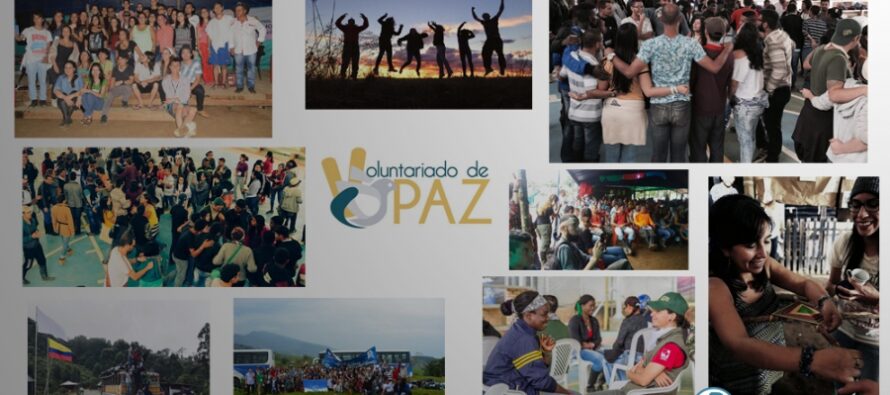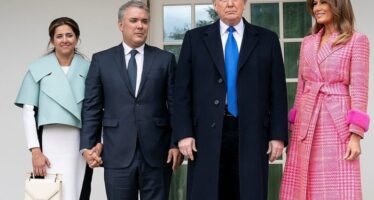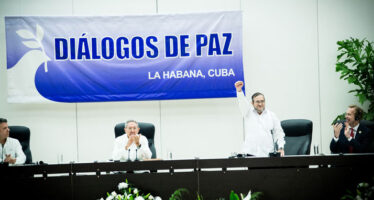Back to Colombia

![]()
The trip to Cartagena had no complications. The flight from Sarpa picked us up at Jose Marti airport in Havana, where we were accompanied by officials from the Foreign Ministry of Cuba, who were as kind and helpful as ever. It was our last farewell, this time we would start the journey without thinking about coming back here.
We were attended by the same stewardess of our trip in late March when we went to the conclave. Upon saying goodbye, she asked me if I would write another chronicle to look for it on the web. The transparency of his dark blue eyes would suffice to transform a rock into a poet. I smiled patronizingly, leaving her standing at the door of the plane.
The white and purple clothes she wore made her even more beautiful.
In Tibú we were told that the helicopter trip to Caño Indio, to the Negro Eliécer Temporary Zone, would last twenty minutes but it actually took ten. From the top there are numerous palm plantations.
We descended on a small elevation. It was two and a half years since I had last been walking on a mountain, the heat stroke was frontal in spite of arriving from Havana.
The drivers of the vehicles have been forced to become experts to overcome the huge muds of the access path to the area. We are told by their responsible that the downpour of the previous night managed to drive away many. More visitors were expected to commemorate the 53rd anniversary of the FARC, but people know what it means to get there when rain has fallen for several hours.
We walked the last few meters to the entrance. A picket of honor of unarmed guerrillas wearing white T-shirts welcomed us with overwhelmed enthusiasm. Timo led our parade and there were many boys and girls who left their post to approach happily to shake his hands. Numerous civilians looked at us with joy as well. Some smiled in such a way that we could not avoid merging with them in a hug.
It was three in the afternoon. The events on the occasion of the 53 years of our foundation were under way since the morning. The voice of the presenter was heard through the loudspeaker. Slogans for peace and agreements. There had been a march in defense of the agreements from inside the camps to its reception area. A gigantic flag of Colombia several meters wide was escorted by fighters without weapons and dressed in white.
The whole day was full of cultural events, dances of various kinds, songs, mime, presentations alluding to the date, greetings from peasant communities, musical performances of the purest folklore. Some wore their clothes and boots smeared with mud. They had come from distant places, and the state of the road extended their journeys beyond any calculation.
That day we did not join the celebration. We arrived tired for the trip and also had to settle in the assigned place, a wooden house covered in zinc, with cement floor, in the most authentic peasant style. A couple of peacocks round the house and the male undertakes his characteristic song at the slightest motive. We go back to sleep under tents, with no air conditioning nor fans. The temperature is very high. Until when the classic storm of the Catatumbo bursts, prolonged downpour, strong winds, lightning and thunder in bulk.
On Sunday 28 I go through all the facilities. The backlog of works is astounding. Only the general classroom is finished. The rest is still in black or without even starting. It will take months of work, even if the materials arrive on time. Guerrillas live in the individual coves they have raised on their arrival in February. They have had to reinforce their tents with creativity. The gales often wreak havoc, but their morale is high.
Now I can greet and talk at length with known fighters, with old loves that arouse great affection and nostalgia. And greet and exchange with many of the civilians who visited the area. Many are relatives of guerrillas, their mothers and fathers, brothers, nephews. Others represent various local or regional organizations. Many young people from Cúcuta and other municipalities of North of Santander.
Venezuelans. Everyone is happy.
The day is devoted to sports competitions. Everyone has the right to participate. The Secretary of Sports of the municipality of Tibú is linked to this part of the program and awards diplomas to those who win. There are micro-football and volleyball tournaments, for men, women and mixed. Teams of guerrillas compete with those of different villages in the region. There are also chess, and domino games. A nice integration.
To the side of the field of micro-football is the wooden floor and zinc roof. There is a sound crew and a guerrilla announcer who encourages players and the public. On the stage everyone who wants to participate goes up: children singing, guerrillas singing peace songs, music of different rhythms playing in turns from the speaker.
By 10.15 a greeting by Timoleón Jiménez is announced. People wait expectantly. A peasant leader with whom I converse tells me of his illusions with peace, of the pedagogical work necessary to get all the communities to endorse the agreements. Another speaks to me of his illusions with the special circumscription of peace, they must win the curul to obtain deserved political representation. They tell me about their work with the communities to get it.
He shares his concerns for the other surviving armed groups. Alexis, a guerrilla I met years ago, introduces me to a brother of his who came with others and his mother to visit him. He explains that they are not blood brothers, because he was an abandoned as a child and collected and raised by that family. All fled the Catatumbo when the paramilitary raid the area in the late nineties. Except for him, who joined the FARC. His brother looks very excited. He explains how much they love him and the joy they feel for the reunion.
A peasant woman of more than seventy years takes the stage singing rancheras on the suffering of the mothers. She is then succeeded by her son, Gabriel, a Catatumbo guerrilla, who now sings in homage to her. I approach her to congratulate her and she tells me that she had fourteen children, several of them, with their daughters-in-law or sons-in-law and their children, accompany her on the visit. Peace is very beautiful, she says. A four-year-old boy shouts slogans to Bolivar’s sword. They applaud him.
Timo’s greeting starts amidst applause and cheers in the audience. He is immediately assaulted by a circle of admirers, some for his autograph and others with his cell phones begging him to please allow them to take a picture by his side.
We must organize a space and devote a long time to that. The journalists of the alternative press present bid for an interview.
Some are satisfied with a greeting or some words of mine, the old man does not have time for all this.
They tell us that our people’s talks with the government in Bogotá are intense and difficult. If there had been concern about delays in the implementation of the agreements before, due to the unfortunate ruling of the Constitutional Court, things seem to be even more complicated now.
It may be true, but there is a fact, the pedagogy for peace grows and the communities feel as their own this struggle for reconciliation.
Hope and possibilities are very great.
There is no other way but to persist and go forward. Also on the side of the court is a kind of altar surrounded by red flowers, in the center of which stand three portraits painted by hand by guerrilla artists. Manuel Marulanda occupies the center, with Raul Reyes to his left and Iván Ríos to his right.
It’s the history of the FARC, which marks 53 years of struggle for peace.
Now peace is closer than ever and we will not allow her to be snatched from us. this is what enthusiastically declare all those people who visit us in solidarity.
Something like this happened in all Transitory Zones and Points. Also in Bogota and other cities.
In Havana there was an OSPAAAL forum for the same purpose.
Timo left his speech written. He had to be in Colombia, starting with the Catatumbo.
We are here, Colombia, nothing and nobody will be able to prevent it.
Cano Indio, May 29, 2017.
Related Articles
Colombia’s peace agreement is in shreds
![]()
Defenseless civilians are under siege. As of October 1, 2018, 343 social leaders and human rights defenders had been assassinated over the course of 18 months
Why are Colombian indigenous peoples protesting against President Ivan Duque?
![]()
Indigenous people are leading a mass movement in Colombia
About Kafir planes at the 26 September Ceremony
![]()
There are many who wonder to what obeyed the menacing warplanes appearance on the scenario at the time the commander of the FARC-EP was finishing to deliver his speech




